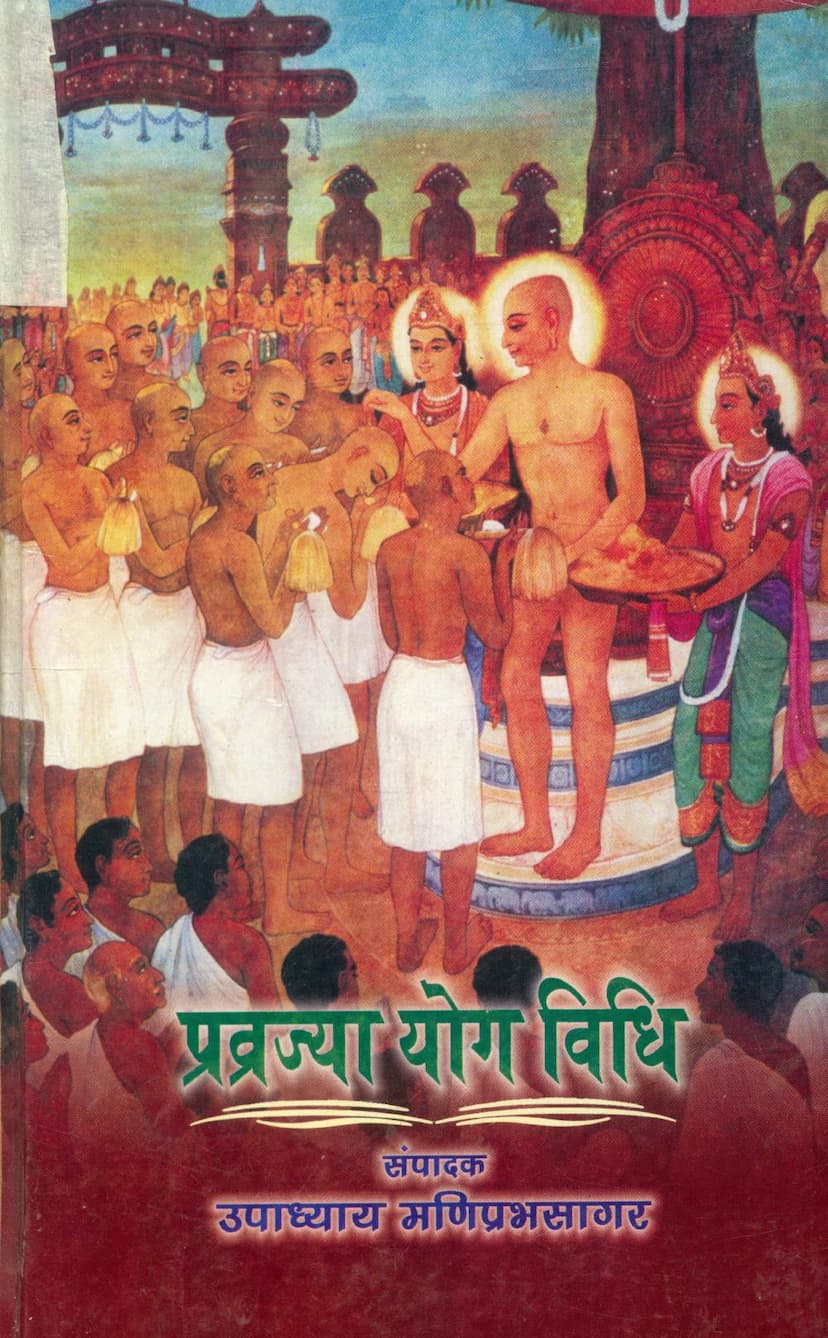Pravrajya Yog Vidhi
Added to library: September 2, 2025

Summary
Here's a comprehensive summary of the Jain text "Pravrajya Yog Vidhi" (Methodology of Renunciation and Yogic Practices), edited by Upadhyay Maniprabhsagar, focusing on the rituals and procedures for the initiation into monastic life within the Khartargachh tradition:
Book Title: Pravrajya Yog Vidhi (Methodology of Renunciation and Yogic Practices) Author: Upadhyay Maniprabhsagar Publisher: Ratanmala Prakashan
Overview:
This book, "Pravrajya Yog Vidhi," compiles the detailed rituals and methodologies for undertaking the "Chhoti Diksha" (minor initiation) and "Badi Diksha" (major initiation) within the Khartargachh tradition of Jainism. It serves as a guide for the correct execution of these sacred ceremonies, emphasizing the importance of specific yogic practices (yogodvahan) that precede the initiation. The book highlights the historical and scriptural basis for these practices and explains the current traditions and their adherence to ancient principles.
Key Themes and Content:
-
Purpose and Need: The book addresses a long-standing need for a comprehensive guide on the Badi Diksha (major initiation) ceremony. While a method for Chhoti Diksha existed, the Badi Diksha method was largely based on handwritten manuscripts. This publication aims to provide a standardized and authoritative text for the practice.
-
Historical and Scriptural Context:
- The text extensively discusses the importance of "Yogodvahan" (yogic practices and purification rituals) as a prerequisite for initiation.
- It cites ancient texts like "Vidhi Prapā," "Āchār Dinakar," and "Samāchārī Shatak" to validate the yogodvahan procedures.
- Historical references, such as a document from V.S. 1633 detailing a decree by Acharya Jinmāṇikyasarī concerning the qualifications for conducting major initiations, are presented. This decree emphasized the completion of yogodvahan of the "Mahānīśīth Sūtra" and specific studies of the "Bhagavati Sūtra" (six months of yogic practice) as prerequisites.
- The text contrasts scriptural requirements with current practices, noting that while ancient texts mandated extensive yogic practices preceding initiation, modern traditions sometimes see a quicker transition, especially in "Laghu Diksha" (minor initiation).
-
Initiation Process (Diksha Vidhi):
- Chhoti Diksha (Minor Initiation): The book outlines the rituals, including the establishment of the "Samavasharan" (a symbolic representation of the divine assembly) with the image of a Tirthankara, purification rituals, prayers, and specific vows. It notes variations in practices, like the recitation of "Sāmāyik Dandak" for different levels of vows (Samyakttva, Deshvirati, Sarvavirati), and discusses the absence of "Deshvirati Sāmāyik Dandak" in some texts and current traditions.
- Badi Diksha (Major Initiation): This section details the more elaborate procedures, starting with the initial request from the disciple's family to the Guru, followed by purification rites, blessings, and the symbolic transformation from a householder to a renunciate. It includes specific rituals like shaving the head ("mundan"), adorning the novice with monastic attire ("vesh"), and the "Sāmāyik Aroopana" (formal acceptance of the vows).
-
Yogodvahan (Yogic Practices):
- The text elaborates on the daily routines and specific practices required during the yogodvahan period, which can be extensive.
- It outlines the procedures for "Āvasyak Sūtra" and "Daśavaikālika Sūtra" yogodvahans, including daily rituals like "Pratikramaṇa" (repentance), "Pratilekhana" (purification of belongings), "Sajjhāya" (study), and various "Niyoga" (assignments).
- The book details the prescribed "tapas" (austerities) during yogodvahan, often involving "Āyambil" (a specific type of fasting) on certain days and "Nirvīkārika" (simple, pure food) on others, as described in texts like "Vidhi Prapā" and "Āchār Dinakar."
-
Specific Rituals and Procedures:
- Nandi Vidhi: The establishment and worship of the "Nandi" (a symbolic representation of the sacred journey) are described, including the purification of the ground, invocation of deities, and offerings.
- Namkaran (Naming Ceremony): The process of bestowing a monastic name on the initiated, often accompanied by the pouring of "Vāskshep" (sanctified rice or powder) and a formal declaration of the lineage and traditions.
- Digbandha (Directional Binding): This ritual is explained as the formal inclusion of the new ascetic into the monastic community and tradition, involving the recitation of the Guru's lineage.
- Chaitra Vandana: Various devotional prayers and recitations, including "Lokasya," "Namostu," and hymns dedicated to specific deities and Tirthankaras, are prescribed.
- Upādhikarma (Blessing of Monastic Utensils): Rituals for sanctifying the monastic implements like the "Rajoharan" (broom for sweeping the path) and "Muhapatti" (mouth cloth) are detailed.
- Praveśana (Entry) and Nīśīthi (Prohibitions): The strict rules and observances during the yogodvahan period are highlighted, including the importance of "Nīśīthi" (saying "Nīśīthi" before entering a sacred space or interacting with elders) and the prohibitions regarding sleep during the day.
-
Discrepancies and Modern Practices:
- The book acknowledges differences between scriptural injunctions and current practices, particularly regarding the duration and intensity of yogodvahan.
- It notes that while scriptures prescribe rigorous practices, modern interpretations and conveniences sometimes lead to shortened or modified procedures.
- The text also discusses the evolution of practices like "Digbandha," which is now sometimes performed during Chhoti Diksha, although historically it was reserved for Badi Diksha.
-
Invocations and Mantras: Numerous Sanskrit and Prakrit invocations and mantras are provided for various stages of the rituals, including those for purification, invocation, blessings, and the specific "Vardhaman Vidya."
-
Structure and Compilation: The book is presented as a compilation based on the vast scriptures and traditions of the Khartargachh, drawing from works like "Vidhi Prapā" and "Āchār Dinakar." It aims to be a practical guide for ascetics and scholars involved in initiating new monks and nuns.
Significance:
"Pravrajya Yog Vidhi" is an important text for understanding the intricate and sacred rituals associated with monastic initiation in the Jain tradition, specifically within the Khartargachh. It underscores the spiritual discipline, scriptural adherence, and meticulous execution required for these life-transforming ceremonies. The book reflects a blend of ancient wisdom and evolving practices, aiming to preserve the sanctity of the initiation process while adapting to contemporary needs.